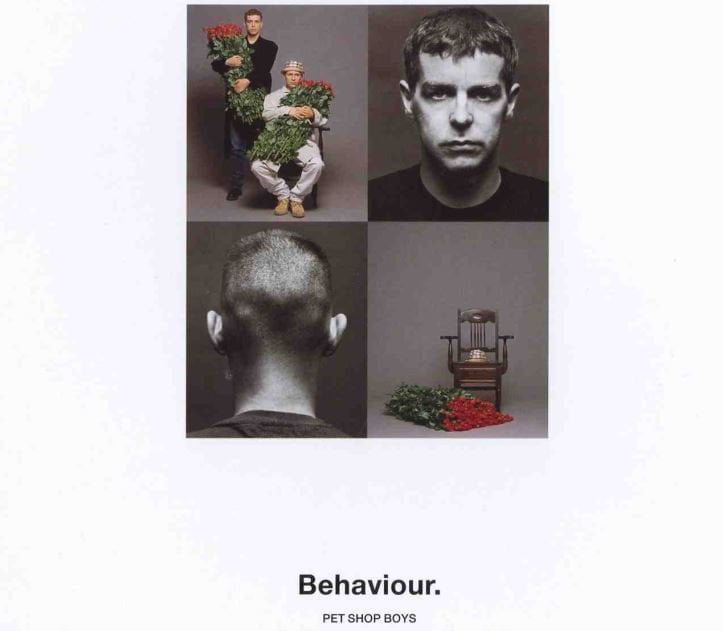
Pet Shop Boys: Behaviour cover
With Pet Shop Boys: Behaviour, Neil Tennant and Chris Lowe created a melancholy classic informed by death and infidelity…
Neil Tennant remembers the moment clearly: it was September 1988 when it unexpectedly came to an end.
“In 1987-88, we had three No.1 singles within the space of a year,” he told Pet Shop Boys biographer Chris Heath in a 1996 documentary broadcast on Radio 1. “And then when Domino Dancing came out, I remember being in a car in Sussex and listening to the chart on the radio, and it came in at No.9. This is a record we thought would go to No.1. I thought, ‘Oh well, that’s it. That’s that over.’” And thus concluded what shall forever be referred to as the Pet Shop Boys’ ‘imperial phase’.
If the album from which Domino Dancing was taken, Introspective, reflected dance culture at the time – with its sprawling, house-inspired tracks – then its follow-up, Behaviour, reacted against it.
Long considered to be the Pet Shop Boys’ ‘mature’ record, Behaviour is in fact a more complex and multi-faceted collection of songs than such a reductive tag would suggest.
From their earliest days, the Pet Shop Boys were ambitious writers of pop classics. Their first demo, recorded when they were still known as West End, comprised three tracks.
Alongside the never-to-be-released Oh Dear! and Bubadubadubadum, both of which bore the influence of Vince Clarke-era Depeche Mode, was an intense song about unrequited love called Jealousy.
Pet Shop Boys: Behaviour
Chris Lowe had written the music for it, on the piano in his parents’ dining room in Blackpool, in the spring of 1982. Tennant later observed that “it’s the first proper song we wrote”. It would finally be released eight years later as the closing track on Behaviour.
Jealously wasn’t the only song from the PSB vaults to find a home on Behaviour. To Face The Truth was completed in 1984, during Tennant and Lowe’s productive three-year period of recording demos in an eight-track studio in Camden run by musician Ray Roberts, while Nervously was primarily written by Tennant, on acoustic guitar, before he met Lowe.
The music for some of the other songs, including Being Boring, How Can You Expect To Be Taken Seriously? and My October Symphony, was put together in 1989 in a small studio in west Glasgow that the Pet Shop Boys had hired – for the simple reason that they’d been to Glasgow on tour and liked it.
As per Nervously years earlier, the songs were written mainly on guitar, and were coloured by a resolutely downbeat sensibility. Although that wasn’t necessarily the plan.
“We didn’t set out to ‘go mature’,” said Tennant in the Radio 1 doc. “We set out, as usual, to make an album where every track could be a single. We used to say at the time we’d started to make 10 Kylie Minogue singles… I think there was an expectation that we would be making a sort of rave, Manchester kind of album. In fact, we were quite influenced by what was going on there but, with the songs we had, it made it sound mellow.”
Pet Shop Boys: Behaviour
Tennant cites one reason for the album’s sense of melancholy as the death of his friend Chris Dowell, who died of an AIDS-related illness in 1989. “But I don’t think you can really say it cast a shadow over the whole album,” said Tennant. “Maybe it set a mood for it that we followed through.”
Tennant and Lowe decided that, for the first time since their debut album Please, they wanted to make a record with one producer. They also decreed they would use analogue synthesizers and eschew samples.
“Even by the beginning of 1990 everything was mega-samples,” Tennant told Heath in the booklet that accompanied the 2001 reissue of Behaviour, “and we wanted to make something much cleaner.”
They were enthused by the disco records made in the 70s by Giorgio Moroder and thought of Harold Faltermeyer, who had been Moroder’s programmer before he went on to compose the music for films such as Beverly Hills Cop (including its memorable theme Axel F) and Top Gun.
After flying to Germany to meet the producer, they agreed that Behaviour would be recorded in Faltermeyer’s Red Deer studio, beginning in April 1990. The recording would take place across a total of 10 weeks, split into two chunks with a month-long break in the middle.
The album was put together using a catalogue of vintage synths. “I mean, you name it, we got it,” recalled Faltermeyer in an interview conducted in 2017 for the online forum Pet Shop Boys Community. “It started with the Moogs, Kurzweil and Roland modular synthesizers, Oberheims, Yamaha. We used the TR-808 drum machines, the 909, the TB-303 – very iconic Roland vintage gear.”
Pet Shop Boys: Behaviour
Faltermeyer was, by his own admission, “an early bird” and would start work in the studio at 5am, organising sounds and prepping synths for the day ahead. Tennant and Lowe would arrive in the late morning from the apartment hotel in the centre of Munich in which they were staying.
Over coffee, they would discuss the day’s agenda. “Most of the time they had a plan when they came in and would say, ‘OK, we have an idea – let’s work on this song,’” said Faltermeyer. “Once we started with a new song, we listened to the demo and I would work up a piano chart, which I needed to play later on.
“Then I started to program a rhythm track and played the first instruments, like bass or the keyboard. Very early on we started to record Neil’s voice because then you can build an arrangement more easily – the voice is obviously the most important thing on a record.”
They would take a break in the afternoon and have a beer – Faltermeyer ran his own microbrewery at the studio complex – before returning to work until around 8pm or 9pm. At which point the Pet Shop Boys would head back into the city for dinner.
Read more: Top 40 Pet Shop Boys singles
Read more: Pet Shop Boys: Actually
“When we’re in the recording studio we’re famous for, ‘At half-past-eight, the Pet Shop Boys will have completely lost interest no matter what’s happening,’ because we’re thinking about the lure of the restaurant around the corner,” Tennant told The Smash Hits Yearbook 1990.
“Sometimes we’ll have someone in doing backing vocals or doing a solo, and Chris storms into the studio and says, ‘Well, how much longer is this going to take? Have you seen what time it is? It’s twenty-past-eight! I’m starving!’”
While Tennant played guitar on some of the tracks, Johnny Marr was later brought in to add guitar to This Must Be The Place I Waited Years To Leave and My October Symphony. Marr first met the Pet Shop Boys by chance in a lift in the Mondrian hotel in Los Angeles in 1987.
Two years later, PSB collaborated with the former Smiths guitarist on his Electronic project with Bernard Sumner. This marked the beginning of an ongoing working relationship between Marr and the Pet Shop Boys, which included appearances by Johnny on PSB’s 2002 album Release and 2009’s Yes.
Only The Wind and This Must Be The Place… also featured an orchestra, recorded at Abbey Road, that was arranged and conducted by Angelo Badalamenti, who was hired by Tennant and Lowe following his work with David Lynch.
Pet Shop Boys: Behaviour
Curiously, though, Badalamenti wasn’t involved in the epic, string-laden Jealousy and, instead, synth strings were used for the album version. A real orchestra was eventually drafted in when the song was re-recorded for its release as a single, in May 1991.
Following their two stints at Red Deer, Tennant and Lowe completed recording and mixed the album at Sarm West in London, where they had previously worked on Actually and Introspective.
According to an interview in the Pet Shop Boys fan club magazine Literally with Bob Kraushaar, one of the two sound engineers who worked on Behaviour, “They ran out of time with [Faltermeyer], so there was quite a lot of time just me and Neil doing vocals in studio four at Sarm.”
The first single was So Hard, due to the simple fact that it was the first song to be completed. Compared to the rest of Behaviour, it harks back more to the disco stomp of PSB’s previous records and sits awkwardly among the collection’s more stately tracks. “I don’t like So Hard,” Lowe later stated. “It’s a blot on this album.”
Still, the song reached No.4 in October 1990 in the UK – not bad for a group transitioning into its post-imperial phase. It was followed four weeks later by Behaviour, the cover of which was made up of four photos: portraits of Tennant and Lowe (the latter facing away from the camera), a still life, and a shot of Tennant and Lowe together, each clutching enormous bunches of roses.
This was inspired by a 1951 photo of Judy Garland by Richard Avedon, which they had seen in Liza Minnelli’s New York apartment.
The photos were taken by Eric Watson, who shot many of the early PSB images and helped create the enduring dynamic of a smartly dressed Tennant in the foreground and Lowe in the background wearing sunglasses and a hat.
Pet Shop Boys: Behaviour
Some critics weren’t quite sure what to make of the analogue, melancholy sound of Behaviour. After all, it didn’t comfortably fit in with the mainstream dance music of the period nor with expectations of what a Pet Shop Boys album should sound like.
While Sounds proclaimed Behaviour to be “about as good as pop music gets”, the NME awarded the album six out of 10, even snarking that My October Symphony is “all somewhat disturbingly John Betjeman goes pop, except that even as a senile old goat our former poet laureate displayed more signs of lust for life”. To which you can only respond: crikey.
“Our albums do tend to get re-evaluated after the event,” said Lowe in the Pet Shop Boys documentary A Life In Pop. “So they might not get a good review at the time but then the opinion changes over the years of what’s good and what isn’t. It’s best to go with your own instincts and do what you want to do.”
Read more: Making Pet Boys Boys – Yes
Read more: The Lowdown – Pet Shop Boys
Pet Shop Boys: Behaviour – the songs
BEING BORING
While Being Boring only peaked at a comparitively lowly No.20 in the UK after it was released as a single in November 1990, it remains one of the Pet Shop Boys’ defining moments. It is closely informed by the AIDS-related death at the age of 34 of Chris Dowell, who had been friends with Neil Tennant from childhood. The three half-sung/half-spoken verses encompass the teenage parties attended by Tennant and Dowell, and Tennant’s move to London in the 1970s before, in the final verse, Neil reflects on his current life, while Dowell has died and other friends are ill. Despite its pensive mood, it is inspired in part by Stock Aitken Waterman: it replicates their oft-used device of moving up a semi-tone into the chorus, and the chord sequence then utilises – of all things – the first part of the chorus to Rick Astley’s Never Gonna Give You Up.
Pet Shop Boys: Behaviour
THIS MUST BE THE PLACE I WAITED YEARS TO LEAVE
Built around a repeated vocoder loop of Chris Lowe saying “everybody jump to attention”, this was originally written in 1986 after it was intimated to Tennant and Lowe that they might be asked to compose the theme song for the next James Bond movie The Living Daylights. “So, as a musical exercise, we decided to write something that sounded, in our opinion, like a James Bond theme,” said Tennant in the booklet with the reissued version of Behaviour. The lyrics are about a dream that Neil used to have in which he was back at grammar school sitting an exam, but also address the fall of communism in the Eastern Bloc.
TO FACE THE TRUTH
This straightforward song sees the narrator struggle to come to terms with the fact that the person he’s in love with is not in love with him, and suspects them of cheating. Musically, it’s rather slight. The line “you are the only one” is taken from the classic film Midnight Cowboy. Tennant originally composed the track on acoustic guitar in the early 80s and subsequently completed it in 1984 with Lowe at the Camden demo studio that they used at the time. The low-in-the-mix synth at the very start of the track is played backwards.
HOW CAN YOU EXPECT TO BE TAKEN SERIOUSLY?
A swingbeat song inspired by Bobby Brown’s Every Little Step, this is a brazen satire of rock musicians and their inflated egos. While it’s clearly targeting the likes of Bono, Bob Geldof and Sting, the lyrics were initially inspired by an interview Bros did on the TV show Wogan, in which they said they were “about longevity”. A superior remix by Brothers In Rhythm was released as a double A-side single, backed by an inspired mash-up of U2’s Where The Streets Have No Name and the Frankie Valli standard Can’t Take My Eyes Off You. When asked to comment, U2 released a statement that read: “What have we done to deserve this?”
ONLY THE WIND
Lowe wrote the music for this on his piano at home in Highbury, to which Tennant added lyrics on the spot in a Notting Hill studio they’d rented in 1990 to work on some tracks – there actually was a gale blowing outside at the time, hence the title. “It’s a very violent song,” said Neil. “The wind is a metaphor for domestic violence and for a huge row.” It’s one of Behaviour’s weaker moments, the highlight being Angelo Badalamenti’s haunting string arrangement.
MY OCTOBER SYMPHONY
This is an elegant fusion of electronic beats, house piano, guitar by Johnny Marr and a string quartet. In lesser hands it could have ended up a mess of ideas but the whole thing glides along seemingly effortlessly. The ambition of the music is matched by the lyrics, which were prompted by the book The New Shostakovich by Ian MacDonald, and consider the plight of a Soviet composer and whether his work is rendered irrelevant following the end of communism.
SO HARD
This was both the first single from Behaviour and totally uncharacteristic of the rest of the album. It’s reminiscent of the more bombastic moments from Please and Actually, and if ever there could be said to be a Pet Shop Boys song-by-numbers, this is it. Much better, in fact, than the album version is a remix by The KLF, which loses the jarring, slashing keyboard motif and strips away most of the vocals, the end result being what sounds like a lost track from Introspective. According to Tennant in his book One Hundred Lyrics And A Poem, the song is “a true story about infidelity in a gay couple I knew… The title is obviously a double entendre”.
NERVOUSLY
This underrated track began life in 1980 – a year before Tennant and Lowe’s fateful meeting in an electronics shop on King’s Road in London – as a guitar song written by Tennant, but it was never completed. It was finally finished 10 years later by Lowe, who came up with the chord sequence at the end of the chorus. The stripped-down arrangement was Harold Faltermeyer’s idea: the song starts with just synthesizers and masterfully builds throughout with the addition of a bassline, brass, strings, guitar and, finally, drums – which only come in around 45 seconds before the song ends. “The lyric is about two gay boys meeting each other and being too shy to have sex,” said Tennant.
THE END OF THE WORLD
What almost ended up as a B-side was instead included in the running order at the last moment when Tennant and Lowe decided to drop Miserablism from the album (it was later released as a B-side to Was It Worth It? in December 1991). The End Of The World is the flimsier of the two songs but is, arguably, a better fit here, a palate cleanser ahead of the epic, album-closing Jealousy. The middle section features a guitar solo by Tennant that was inspired by Depeche Mode’s Enjoy The Silence.
JEALOUSY
Another song from the archives – it can be traced back to 1982 – this swells into one of the Pet Shop Boys’ most grandiose moments, up there with It’s A Sin for sheer drama. “Chris had said he wanted it to be very intense, so I wrote about jealousy,” said Tennant. “When I first met Chris, my other friend called Chris was very jealous, and that inspired the song.” The single version, released in May 1991, was remodelled to include a real orchestra. The group had always wanted Ennio Morricone to arrange it but he never replied to them.
Go to Pet Shop Boys’ official website
Read our article on the cover art of Depeche Mode
Classic Pop may earn commission from the links on this page, but we only feature products we think you will enjoy.


